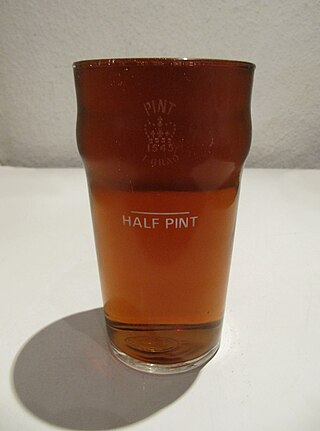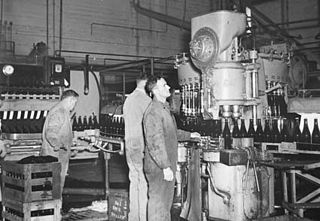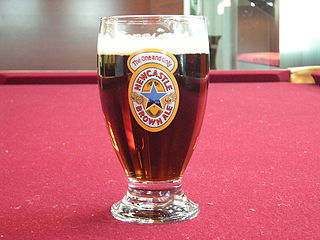
A fill line is a marking on drinkware indicating the volume of liquid held by the glass. Many countries mandate fill lines on glasses used commercially as a consumer protection measure. [1]

A fill line is a marking on drinkware indicating the volume of liquid held by the glass. Many countries mandate fill lines on glasses used commercially as a consumer protection measure. [1]

Each of the European Union member states had a variety of weights and measures acts regarding legal metrology for all measuring devices used in commerce, including drinkware. As part of the EU's 2004 Measuring Instruments Directive (2004/22/EC), these were harmonised. The transitional period ended on 30 October 2016, meaning all drinkware produced or sold in the EU or Switzerland [2] after this date must conform to the EU directive.
In Austria, fill lines are governed by the Beverage Container Regulation (German : Schankgefäßeverordnung), which provides error tolerances; glasses between 10 and 50 ml must be within 5% of the declared volume; larger containers must be accurate within 3%. [3]

Germany has had a number of weights and measures acts specifically addressing volumetric markings on glassware. Local and state laws have since been superseded by the federal Mess- und Eichgesetz ("Measurement and Calibration Act"), which in turn was updated to implement the EU directive.
All glassware used in a commercial setting is required to have a marking indicating the volume of the container, along with an identifier that indicates the manufacturer. The manufacturer identifiers are issued by the Physikalisch-Technische Bundesanstalt in Braunschweig, such as "Bö" for Böckling, "ra" or "rastal" for Rastal, or "Sahm" for "Sahm", or "Kö" for Kössinger.
The technical specifications are written towards ensuring consumer protection. The fill line must be horizontal and at least 10 mm long; depending on the size of the glass, a certain distance is required to the rim of the glass. Some glasses may also have a second fill line half-way down the glass.
In countries using Imperial units, fill lines are not as common for pint glasses. In the United Kingdom, pint glasses typically hold one imperial pint (20 imp fl oz; 568 ml) when filled to the brim. Pint glasses commonly have a fill line for the volume of one-half of an imperial pint (284 ml).
Although the glass must be accurately-calibrated, industry guidelines only require a pint to be at least 95% liquid, allowing 5% of the pint to consist of the foamy 'head'. [4] [5] The Campaign for Real Ale (CAMRA) has described this practice as selling a short measure, and says that it costs drinkers £1m a day in beer they have paid for but not received. The British Beer and Pub Association has issued guidelines for bar staff to give a 'top up' to any drinker who is unsatisfied with the measure they receive. [6]
CAMRA recommends the use of "lined" or "oversized" glasses in pubs. These have a line near the top (usually labelled "pint to line") to which the beer should be poured, with the head forming above it.

Real ale is the name coined by the Campaign for Real Ale (CAMRA) for beer that is "brewed from traditional ingredients, matured by secondary fermentation in the container from which it is dispensed, and served without the use of extraneous carbon dioxide".

The pint is a unit of volume or capacity in both the imperial and United States customary measurement systems. In both of those systems it is traditionally one eighth of a gallon. The British imperial pint is about 20% larger than the American pint because the two systems are defined differently. Almost all other countries have standardized on the metric system, so although some of them still also have traditional units called pints, the volume varies by regional custom.

A standard drink or unit of alcohol is a measure of alcohol consumption representing a fixed amount of pure alcohol. The notion is used in relation to recommendations about alcohol consumption and its relative risks to health. It helps to educate alcohol users. A hypothetical alcoholic beverage sized to one standard drink varies in volume depending on the alcohol concentration of the beverage, but it always contains the same amount of alcohol and therefore produces the same amount of drunkenness. Many government health guidelines specify low to high risk amounts in units of grams of pure alcohol per day, week, or single occasion. These government guidelines often illustrate these amounts as standard drinks of various beverages, with their serving sizes indicated. Although used for the same purpose, the definition of a standard drink varies from country to country.

A beer bottle is a bottle designed as a container for beer. Such designs vary greatly in size and shape, but the glass commonly is brown or green to reduce spoilage from light, especially ultraviolet.
The Metric Martyrs was a British advocacy group who campaigned for the freedom to choose what units of measurement are used by traders. The group believed that vendors should have the freedom to mark their goods with imperial weights and measurements alone. This opposes the current legal position that imperial units may be used so long as metric units are also displayed.

Beer has been brewed in England for thousands of years. As a beer brewing country, it is known for top fermented cask beer which finishes maturing in the cellar of the pub rather than at the brewery and is served with only natural carbonation.

Beer is a major part of German culture. According the Reinheitsgebot, only water, hops, yeast and malt are permitted as ingredients in its production. Beers not exclusively using barley-malt, such as wheat beer, must be top-fermented.

Beer arrived in Australia at the beginning of British colonisation. In 2004 Australia was ranked fourth internationally in per capita beer consumption, at around 110 litres per year; although, the nation ranked considerably lower in a World Health Organization report of alcohol consumption per capita of 12.2 litres. Lager is by far the most popular type of beer consumed in Australia.

A pint glass is a form of drinkware made to hold either a British imperial pint of 20 imperial fluid ounces (568 ml) or an American pint of 16 US fluid ounces (473 ml). Other definitions also exist, see below. These glasses are typically used to serve beer, and also often for cider.

Metrication is the act or process of converting to the metric system of measurement. The United Kingdom, through voluntary and mandated laws, has metricated most of government, industry, commerce, and scientific research to the metric system; however, the previous measurement system is still used in society. Imperial units as of 2024 remain mandated by law to still be used without metric units for speed and distance road signs, and the sizes of cider and beer sold by the glass, returnable milk containers and precious metals, and in some areas both measurement systems are mandated by law.

Various unique terms are used in bartending.

Metrication in the Republic of Ireland happened mostly in the 20th century and was officially completed in 2005, with a few exceptions.
Alcohol measurements are units of measurement for determining amounts of beverage alcohol.

A wine glass is a type of glass that is used for drinking or tasting wine. Most wine glasses are stemware (goblets), i.e., they are composed of three parts: the bowl, stem, and foot.

Beer glassware comprise vessels made of glass, designed or commonly used for serving and drinking beer. Styles of glassware vary in accord with national or regional traditions; legal or customary requirements regarding serving measures and fill lines; such practicalities as breakage avoidance in washing, stacking or storage; commercial promotion by breweries; artistic or cultural expression in folk art or as novelty items or usage in drinking games; or to complement, to enhance, or to otherwise affect a particular type of beer's temperature, appearance and aroma, as in the case of its head. Drinking vessels intended for beer are made from a variety of materials other than glass, including pottery, pewter, and wood.
A pony glass may mean one of two types of small glassware:

A schooner is a type of glass for serving drinks. In the United Kingdom it is the name for a large sherry glass. In Australia it is the name for a particular glass size, used for any type of beer.

A faceted glass or granyonyi stakan is a type of drinkware made from especially hard and thick glass and having a faceted form. It is a very widespread form of drinking glass in Russia and the former Soviet Union.

The rum ration was a daily amount of rum given to sailors on Royal Navy ships. It was abolished in 1970 after concerns that the intake of strong alcohol would lead to unsteady hands when working machinery.